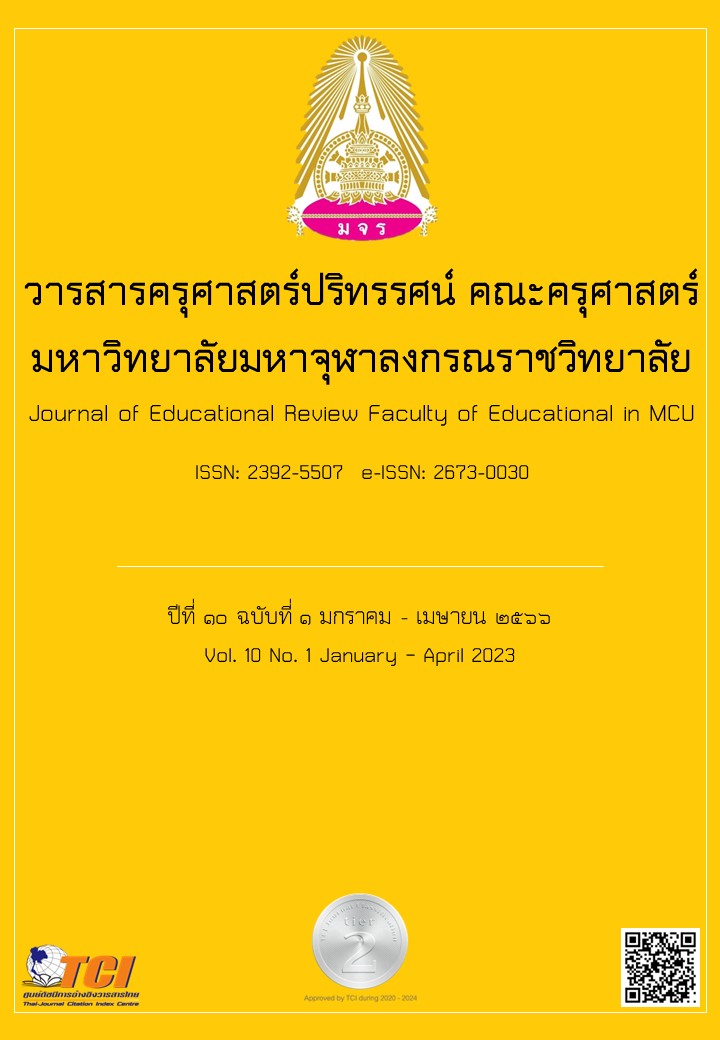DEVELOPMENT OF A LEARNING MODEL USING FOUR BLOCKS APPROACH AND MIND MAPPING TECHNIQUE TO ENHANCE READING FOR MAIN IDEA ABILITY FOR MATTHAYOMSUKSA 1 STUDENTS
Main Article Content
Abstract
The aims of this article were 1) to study the basic information to develop a learning model by employing the Four Blocks approach and the Mind Mapping technique in order to promote reading for main idea ability among Matthayomsuksa 1 students; 2) to develop and find effectiveness of the developed learning model by using the Four Blocks approach and the mind mapping technique to promote the reading for main idea ability for Matthayomsuksa 1 students to reach the effective criteria of 80/80; 3) to try out the developed model by using the Four Blocks approach and the mind mapping technique to increase the reading for main idea ability for Matthayomsuksa 1 students, and 4) to assess the learning achievement and satisfaction of students toward the learning by using the Four Blocks approach and the mind mapping technique. The sample group consisted of 33 Matthayomsuksa 1 students studying in 1/3 classroom of Tessaban Banmuang School, Kaengkhoi district, Saraburi province in the semester 1 of the academic year 2020. They were acquired by using a cluster random sampling. This research is considered the research and development. Research instruments were 1) the developed learning model; 2) learning achievement test, and satisfaction questionnaire. Findings revealed that 1) regarding the basic information study, it was found that the Four Blocks was an approach used to teach reading skills by allowing opportunities for experts, teachers, and students agreed on needs to develop the learning model; 2) there were 4 steps of learning which consisted of (1) self-choose reading; (2) studying words/stories; (3) recommended reading/practicing reading strategies, and (4) reflections and summary writing. The efficiency E1/E2 of the field tryout was 82.23/87.36; 3) the model tryout result E1/E2 was 82.64/87.47, and 4) the assessment and improvement showed that learning achievement before and after executing the model was different at a statistical significant level of .01 and the students expressed their satisfaction at the highest level.
Article Details

This work is licensed under a Creative Commons Attribution-NonCommercial-NoDerivatives 4.0 International License.
ทัศนะและความคิดเห็นที่ปรากฏในบทความในวารสารฉบับนี้ถือเป็นความรับผิดชอบของผู้เขียนบทความนั้นเพียงผู้เดียว และไม่ถือเป็นทัศนะและความรับผิดชอบของกองบรรณาธิการ
กองบรรณาธิการขอสงวนสิทธิ์ในการคัดเลือกบทความลงตีพิมพ์และจะแจ้งให้เจ้าของบทความทราบหลังจากผู้ประเมินบทความตรวจอ่านบทความแล้ว
ต้นฉบับที่ได้รับการตีพิมพ์ในวารสารครุศาสตร์ปริทรรศน์ คณะครุศาสตร์ มหาวิทยาลัยมหาจุฬาลงกรณราชวิทยาลัย ถือเป็นกรรมสิทธิ์ของคณะครุศาสตร์ มหาวิทยาลัยมหาจุฬาลงกรณราชวิทยาลัย ห้ามนำข้อความทั้งหมดหรือบางส่วนไปพิมพ์ซ้ำ เว้นเสียแต่ว่าจะได้รับอนุญาตจากมหาวิทยาลัยฯ เป็นลายลักษณ์อักษร
References
กระทรวงศึกษาธิการ. (2551). หลักสูตรแกนกลางการศึกษาขั้นพื้นฐานพุทธศักราช 2551. กรุงเทพมหานคร: กระทรวงศึกษาธิการ.
กระทรวงศึกษาธิการ. (2552). สาระและมาตรฐานการเรียนรู้กลุ่มสาระการเรียนรู้ภาษาไทยในหลักสูตรการศึกษาขั้นพื้นฐานพุทธศักราช 2551. กรุงเทพมหานคร: โรงพิมพ์องค์การรับส่งสินค้าและพัสดุภัณฑ์.
นิธิวดี จรัสดี. (2557). การพัฒนาการอ่านจับใจความ โดยใช้เทคนิคการฝึกกลวิธีการเรียนรู้ร่วมกับการสอนแบบโฟร์บล็อก. วารสารวิชาการ Veridian E-Journal. 7(1). 124.
โรงเรียนเทศบาลบ้านม่วง. (2560) ผลสัมฤทธิ์ทางการเรียนของนักเรียนชั้นมัธยมศึกษาปีที่ 1 กลุ่มสาระการเรียนรู้ภาษาไทย. สระบุรี: โรงเรียนเทศบาลบ้านม่วง.
อุษณีย์ ขำกัน. (2547). การพัฒนาความสามารถทางการอ่านภาษาไทย โดยใช้แนวการสอนแบบโฟร์บล็อก สำหรับนักเรียนชั้นประถมศึกษาปีที่ 6. วิทยานิพนธ์ครุศาสตรมหาบัณฑิต. จุฬาลงกรณ์มหาวิทยาลัย.
Cunninigham, Hall and Sigmon. (1998). Four – Blocks. From www.Four–Blocks.com/research. Retrieved December 18, 2002.
Comb. (2003). Reader and writers in middle grades. New Jerser: Pearson.
Golden & Gulthire. (1996). Four – Blocks. From https://book.pbru.ac.th/multim/thesis/72724/72724_chapter2.pdf. Retrieved July 5, 2019.


